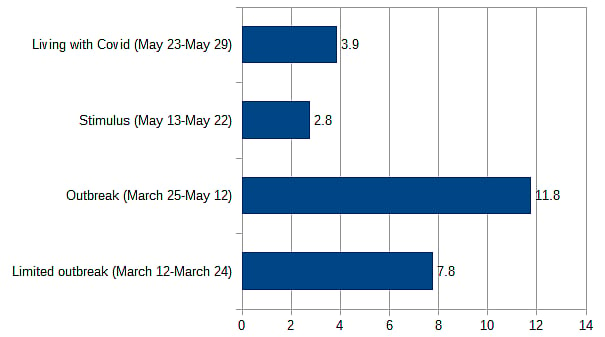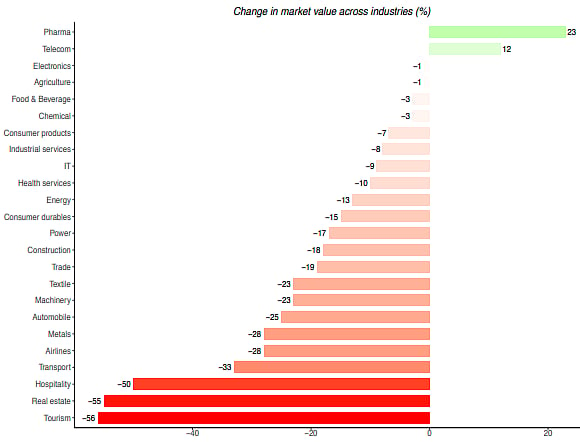Indian state sector ‘outperforms’ private cos by 3-12% during lockdown: IIM-A study
A major study, released by IIM-A, has found that “the government-owned firms have outperformed the private counterparts” during the COVID-19 crisis

A major study, released by the Indian Institute of Management-Ahmedabad (IIM-A), first of its kind on “heightened uncertainty in product markets, business operations, and financing plans” of Indian firms during the COVID-19 crisis, has found that “the government-owned firms have outperformed the private counterparts.”
Dividing the impact of COVID-19 crisis on Indian firms into different stages for the sake comparing public and private sector firms – Limited Outbreak (March 12-March 24), Outbreak (March 25-May 12), Stimulus (May 13-May 22), and Living With COVID-19 (May 25-May 29) -- the study finds that during each, state-owned firms “outperformed the firms affiliated to a business group by 7.8, 11.8, 2.8, and 3.9 percentage points, respectively.

Titled “When the market went viral: COVID-19, stock returns, and firm characteristics”, the study states that the “relatively low market value loss of the state-owned firms is especially evident during the onset of the crisis (until the Outbreak stage).” However, it claims, with stimulus measures announced by the Government of India, “The wedge has narrowed between the government owned firms and the private-sector counterparts.”
The study, which has been authored by Prof Balagopal Gopalakrishnan of IIM-Kolkata, Prof Joshy Jacob of IIM-A, and IIM-A PhD students Avijit Bansal and Pranjal Srivastava, believes, “The lower erosion in market value of the state owned firms could be linked to their softer budget constraints and anticipated fiscal spending in providing a safer avenue for investors.
It predicts, the "lesser impact" on the market value of state-owned firms could lead to greater role of state "in the post-pandemic recovery.” Giving overall picture of the industry, the study says, “Unlike in the advanced economies, which are better prepared to face a pandemic with greater access to healthcare and financial resources, emerging markets like India with (a) poor public health infrastructure; (b) slowing economic growth; and (c) stressed banking and shallow bond market, face steeper challenges in dealing with the fallout of the pandemic.”
As a result of these “challenges”, it says, “The Indian equity market (Nifty) rapidly shed nearly 40% of its market value by March 24, 2020 compared to its value in the beginning of the year. While the decline is closer to that of the Standard & Poor (S&P) 500 (34%), the recovery (a shortfall of 25%) by the end of May 2020 is sub-par relative to that of S&P 500 (a shortfall of 12%).” During the entire period up to May-end, the study says, “The worst affected industries are tourism, real estate and hospitality, where the market value losses exceed 50%. Admittedly they are directly impacted by the lockdowns and the social distancing measures.”
It adds, “Their value loss is also reflective of the likely contraction in discretionary spending by households and businesses. Seven industries out of 24 have lost at least a quarter of their market capitalization in the five month period. Industries that added value to investors during the pandemic are pharmaceuticals and telecommunications.”
Thus, the study finds that the market value of the tourism sector went down by 56%, followed by real estate 55%, hospitality 50%, transport 33%, airlines 28%, metals 28%, automobile 25%, machinery 23%, textile 23%, trade 19%, construction 18%, power 17%, consumer durables 15%, energy 13% health services 10%, IT 9%, industrial services 8%, and consumer products 7%.
Four sectors have suffered marginally – chemical 3%, food and beverage 3%, agriculture 1%, and electronics 1%. Two sectors, for obvious reasons, the market value has went up considerably – telecommunications 12% and pharmaceuticals 23%.
The reason for such sharp fall in market value in most industry sectors, says the study, is that “India witnessed one of the strictest lockdowns in the world, which even restricted intrastate movement of goods and people for a prolonged period.” It adds, “Even after easing of lockdowns, production facilities and offices face the risk of shutdown due to infections among employees.”

The study is based on “firm-level stock return data of the listed firms in India from December 2, 2019 to May 29, 2020”, banking on firms listed with the National Stock Exchange (NSE) and the Bombay Stock Exchange (BSE) as of January 2020, excluding the financial sector firms.
Of the 4,000 firms that were selected, the study excludes firms with “negative book value of equity and negative sales.” As for the remaining firms, study “chooses the top 500 firms for the main analysis, which contribute to more than 95% of the total market capitalization in the Indian market.” The sampled firms, it says, “have relatively higher liquidity”, with their median asset value being Rs 32.59 billion and market capitalization at Rs 41.05 billion.
The study says, “Among the private-sector firms, firms with affiliation to a business group outperforms the non-affiliated firms. For instance, during the Outbreak phase, the unaffiliated firms suffer nearly 3.2% greater loss of market value as compared to the firms affiliated to the business groups”, even though the markets were “somewhat dismissive” of the impact of the pandemic in the initial phase but “quickly corrected as the contagion became evident within a span of weeks.”
The study says, “Firms with higher promoter ownership and firms with affiliation to a business group are expected to better navigate through the pandemic. It is likely that the deeper access of the group firms to financial and other resources would nourish them back to health from the brink of crisis.”
(This article was first published in Counterview)
Follow us on: Facebook, Twitter, Google News, Instagram
Join our official telegram channel (@nationalherald) and stay updated with the latest headlines
